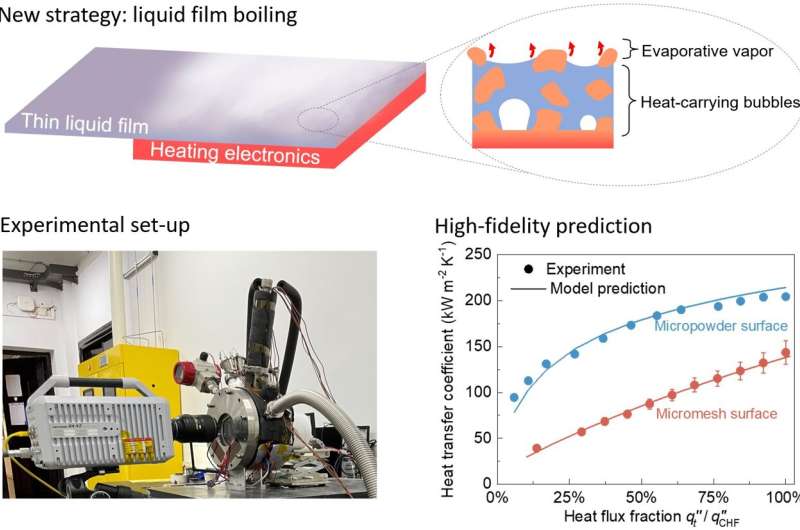This article has been reviewed according to Science X's editorial process and policies. Editors have highlighted the following attributes while ensuring the content's credibility:
fact-checked
trusted source
proofread
A high-fidelity model for designing efficient thermal management surfaces

In the past decade, fires from electronic devices and batteries, from small smartphones to electrical vehicles and airplanes, have repeatedly made headlines. Enhanced computational power has led to a large amount of waste heat generation and undesirable temperature rise of electronics.
Poor heat management is the cause of over half of electronic device failures. To tackle this issue, it is crucial to develop advanced cooling technologies to effectively manage heat and maintain temperatures in the working conditions.
Among various cooling technologies, liquid-vapor phase-change cooling, which utilizes the boiling or evaporation of liquids, is gaining attention due to its superior heat dissipation ability. For instance, the immersion cooling method, similar to boiling water, immerses high-power electronic components in a liquid pool for cooling.
However, researchers have found that relying solely on either boiling bubbles or evaporation no longer meets heat dissipation needs of electronic devices. A few years ago, Professor Ronggui Yang's team proposed a new strategy that employs both evaporation and nucleate boiling and called it capillary-driven liquid film boiling.
This cooling technology generates boiling bubbles in an evaporative thin liquid film by a careful design of the wicking structured surface. This kind of wicking surface is often controlled with a thickness of less than 1 millimeter. Leveraging the benefits of both boiling and evaporation which have been well studies over a century, the new strategy of liquid film boiling achieves high heat dissipation performance, surpassing the heat dissipation limit of traditional phase-change heat transfer.
High heat transfer performance relies on delicate surface design. With the recent development of the micro-nano technologies, researchers are performing the studies on many micro/nano-structures surfaces to enhance heat transfer.
However, current surface designs for liquid film boiling are typically based on experience and lack theoretical guidance. This is due to the complex liquid-vapor phase change process, which involves complicated dynamics of bubbles and liquid film, and the resultant heat transfer. The textured structures of different surfaces further increase the complexity, making the prediction of the heat dissipation capability a long-term challenge, therefore hindering the development of optimal surfaces.
In response to this challenge, a team of researchers led by Professor Yang at Huazhong University of Science and Technology in Wuhan, China, developed a high-fidelity model to predict the liquid film boiling heat transfer on various textured surfaces. The findings are published in the journal National Science Review.
Being able to predict not only heat dissipation but also surface temperature, the model can predict the heat dissipated through different phase change modes (evaporation or boiling). The model predictions for various textured surfaces agree well with experimental data.
The new model is expected to guide the design of new heat management surfaces. This is of great importance for devising high-performance cooling strategies for next-generation electronics.
More information: Pengkun Li et al, A heat transfer model for liquid film boiling on micro-structured surfaces, National Science Review (2024). DOI: 10.1093/nsr/nwae090




















